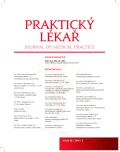Occupational diseases reported in the Czech Republic in 2017
Authors:
Z. Fenclová 1,2; P. Urban 1,2; D. Pelclová 2; D. Havlová 1; M. Voříšková 1
Authors‘ workplace:
Státní zdravotní ústav, Praha Centrum hygieny práce a pracovního lékařství Vedoucí: MUDr. Michael Vít, Ph. D.
1; Klinika pracovního lékařství 1. LF UK a VFN, Praha Přednosta: doc. MUDr. Sergej Zacharov, Ph. D
2
Published in:
Prakt. Lék. 2018; 98(2): 51-58
Category:
Reviews
Overview
A total of 1,370 cases of occupation-related diseases in 1,117 workers were reported in the Czech Republic in 2017. Of these, 1,278 were occupational diseases and 92 cases were given the status of “endangerment by an occupational disease”. The incidence of occupational diseases was 29.6 cases per 100,000 health insured employees in the public sector. Most of the occupational diseases occurred in the Moravian-Silesian region (473 cases, i.e. 34.5%). Most of the recognized cases occurred in the “manufacture of motor vehicles” economic sector (213 cases, i.e. 15.5%). Carpal tunnel syndrome (472 cases, i.e. 36.9%) and contact allergic dermatitis (131 cases, i.e. 10.3%) were the most frequently reported occupational diseases. Among the cases reported as “endangerment by an occupational disease”, the carpal tunnel syndrome predominated (66 cases, i.e. 71.7%)
Keywords:
occupational diseases – endangerment by occupational disease – incidence – trends in occupational diseases
Sources
1. Státní zdravotní ústav. Nemoci z povolání v České republice [online]. Dostupné z: http://www.szu.cz/publikace/data/nemoci-z-povolani-a-ohrozeni-nemoci-z-povolani-v-české-republice [cit. 2018-02-22].
2. Vláda ČR. Nařízení vlády č. 290/1995 Sb., kterým se stanoví seznam nemocí z povolání, ve znění nařízení vlády č. 168/2014 Sb.
3. Fenclová, Z., Urban, P., Pelclová, D., a kol. Profesionální onemocnění hlášená v České republice v roce 2016. Prakt. Lék. 2017; 97(4): 156–162.
Labels
Addictology Allergology and clinical immunology Anaesthesiology, Resuscitation and Inten Angiology Audiology Clinical biochemistry Dermatology & STDs Paediatric dermatology & STDs Paediatric gastroenterology Paediatric gynaecology Paediatric surgery Paediatric cardiology Paediatric neurology Paediatric clinical oncology Paediatric ENT Paediatric pneumology Paediatric psychiatry Paediatric radiology Paediatric urologist Diabetology Endocrinology Pharmacy Clinical pharmacology Physiotherapist, university degree Gastroenterology and hepatology Medical genetics Geriatrics Gynaecology and obstetrics Haematology Hygiene and epidemiology Hyperbaric medicine Vascular surgery Chest surgery Plastic surgery Medical virology Intensive Care Medicine Cardiac surgery Clinical speech therapy Clinical microbiology Nephrology Neonatology Neurosurgery Neurology Nuclear medicine Nutritive therapist Obesitology Ophthalmology Orthodontics Orthopaedics ENT (Otorhinolaryngology) Anatomical pathology Paediatrics Pneumology and ftiseology Burns medicine Occupational medicine General practitioner for children and adolescents General practitioner for adults Orthopaedic prosthetics Clinical psychology Radiodiagnostics Radiotherapy Rehabilitation Reproduction medicine Nurse Sexuology Forensic medical examiner Dental medicine Sports medicine Toxicology Trauma surgery Urology Laboratory Home nurse Phoniatrics Health Care Dental Hygienist Medical studentArticle was published in
General Practitioner

2018 Issue 2
- Memantine in Dementia Therapy – Current Findings and Possible Future Applications
- Metamizole vs. Tramadol in Postoperative Analgesia
Most read in this issue
- Survival after resection of oesophageal cancer
- Overview of questionnaires and scales of the quality of life and non-motor symptoms of patients with Parkinson’s disease
- Comparison of ankle brachial index with ultrasonographic examination of lower limb arteries in diabetics
- The parent-child physical activity of Czech families with normal weight children and overweight or obese children
